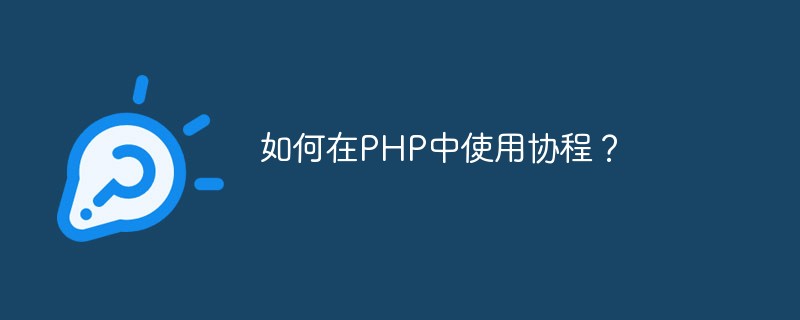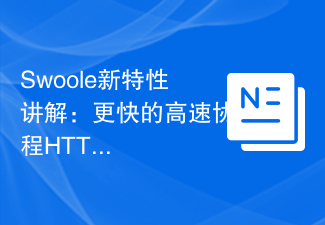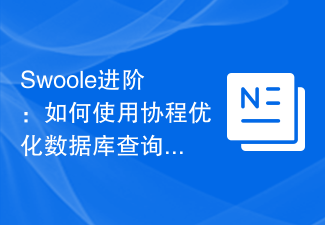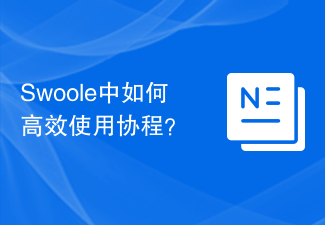The reason why Go coroutine blocks is that blocking operations (such as file I/O) cause the coroutine to enter a waiting state and suspend execution. To avoid blocking, best practices should be followed, such as avoiding heavy I/O operations in coroutines. Use non-blocking alternatives such as channels and select statements. Encapsulate blocking operations in a separate goroutine.

Revealing the blocking mystery of Golang coroutines
Coroutines are powerful concurrency tools in Go, but they sometimes There is a blocking problem. This article will delve into the blocking mechanism of Go coroutines and show how to avoid and debug such problems through practical cases.
The principle of coroutine blocking
Coroutines are essentially lightweight threads that share memory but perform independent tasks. When a coroutine performs a blocking operation (such as file I/O or waiting for channel data), it enters the wait state. At this point, the operating system scheduler will suspend the execution of the coroutine until the blocking operation is completed.
Avoid coroutine blocking
To avoid coroutine blocking, the following best practices should be followed:
- Avoid executing within a coroutine Heavy I/O operations.
- Instead of blocking operations, use non-blocking alternatives such as channels and select statements.
- Encapsulate the blocking operation in a separate goroutine to prevent the blocking coroutine from propagating to other coroutines.
Practical case for solving coroutine blocking
Consider the following code segment:
package main
import (
"fmt"
"time"
)
func main() {
ch := make(chan int)
go func() {
time.Sleep(1 * time.Second)
ch <- 42
}()
fmt.Println("Waiting for channel data...")
val := <-ch // 阻塞协程
fmt.Printf("Received value: %d\n", val)
}In this example, the main coroutine will block On the channel receive operation, because it waits for the sub-coroutine to send data to the channel. To solve this problem, you can use the select statement:
package main
import (
"fmt"
"time"
)
func main() {
ch := make(chan int)
go func() {
time.Sleep(1 * time.Second)
ch <- 42
}()
select {
case val := <-ch:
fmt.Printf("Received value: %d\n", val)
case <-time.After(2 * time.Second):
fmt.Println("Timeout reached, no data received.")
}
}Using the select statement, the main coroutine can set a timeout to continue execution after a period of time, even if the channel reception operation is not completed.
Summary
It is crucial to understand the principle of coroutine blocking in order to avoid such problems in Go programs. By adopting non-blocking techniques and using tools such as select statements, you can prevent coroutines from blocking and maintain concurrency in your code.
The above is the detailed content of Revealing the mystery of blocking in Golang coroutines. For more information, please follow other related articles on the PHP Chinese website!
 如何在PHP中使用协程?May 12, 2023 am 08:10 AM
如何在PHP中使用协程?May 12, 2023 am 08:10 AM随着传统的多线程模型在高并发场景下的性能瓶颈,协程成为了PHP编程领域的热门话题。协程是一种轻量级的线程,能够在单线程中实现多任务的并发执行。在PHP的语言生态中,协程得到了广泛的应用,比如Swoole、Workerman等框架就提供了对协程的支持。那么,如何在PHP中使用协程呢?本文将介绍一些基本的使用方法以及常见的注意事项,帮助读者了解协程的运作原理,以
 如何在Swoole中使用协程实现高并发的swoole_smtp_auth函数Jun 25, 2023 am 08:28 AM
如何在Swoole中使用协程实现高并发的swoole_smtp_auth函数Jun 25, 2023 am 08:28 AM近年来,随着互联网应用的日益普及,各种高并发的场景也越来越常见。在这种情况下,传统的同步I/O方式已经无法满足现代应用对高性能、高并发的需求。因此,协程成为了一种被广泛应用的解决方案。Swoole是一款面向高并发、高性能的PHP网络通信框架,可以轻松实现异步、协程等特性。swoole_smtp_auth函数是其中一个常用的函数,它可以在使用SMTP协议进行邮
 满满的干货!全面的介绍Python的协程是如何实现!看懂算你牛!May 02, 2023 am 10:34 AM
满满的干货!全面的介绍Python的协程是如何实现!看懂算你牛!May 02, 2023 am 10:34 AM如果你需要访问多个服务来完成一个请求的处理,比如实现文件上传功能时,首先访问Redis缓存,验证用户是否登录,再接收HTTP消息中的body并保存在磁盘上,最后把文件路径等信息写入MySQL数据库中,你会怎么做?首先可以使用阻塞API编写同步代码,直接一步步串行即可,但很明显这时一个线程只能同时处理一个请求。而我们知道线程数是有限制的,有限的线程数导致无法实现上万级别的并发连接,过多的线程切换也抢走了CPU的时间,从而降低了每秒能够处理的请求数量。于是为了达到高并发,你可能会选择一
 Swoole新特性讲解:更快的高速协程HTTP服务器Jun 15, 2023 pm 08:16 PM
Swoole新特性讲解:更快的高速协程HTTP服务器Jun 15, 2023 pm 08:16 PM近年来,随着移动互联网、云计算、大数据等新技术的快速发展,越来越多的企业开始使用PHP构建高并发、高性能的Web应用程序。而传统的LAMP(Linux、Apache、MySQL、PHP)架构,难以满足当前互联网快速发展的需求,因此出现了一些新的PHP框架和工具,比如Swoole。Swoole是一个PHP的网络通信框架,具有协程、异步IO、多进程等优势,可以帮
 Swoole进阶:如何使用协程优化数据库查询Jun 15, 2023 pm 09:52 PM
Swoole进阶:如何使用协程优化数据库查询Jun 15, 2023 pm 09:52 PM随着Web应用程序的迅速发展,开发者们不仅要关注应用程序的功能和可靠性,还要考虑应用程序的性能。而数据库操作一直是Web应用程序的一个瓶颈之一。传统的数据库查询方式通常是通过多线程或者多进程来实现,这个方法效率低下,而且不容易管理。而Swoole的协程特性可以用来优化数据库查询,并提高应用程序的性能。Swoole是一款PHP的高性能网络框架。它有一个非常重要
 Go 语言中的协程和 select 语句的联系是什么?Jun 10, 2023 am 09:45 AM
Go 语言中的协程和 select 语句的联系是什么?Jun 10, 2023 am 09:45 AMGo语言中的协程和select语句的联系是什么?随着计算机的发展,我们对于并发编程的需求也越来越迫切。然而,传统的并发编程方法——基于线程和锁——也逐渐变得复杂并容易出错。为了解决这些问题,Go语言引入了一种新的并发编程模型——协程。协程是由语言自己调度的轻量级线程,在协程中,代码的执行是基于非抢占式的协作式调度的,换句话说,每个协程都会执行一段代码
 Swoole中如何高效使用协程?Jun 13, 2023 pm 07:15 PM
Swoole中如何高效使用协程?Jun 13, 2023 pm 07:15 PMSwoole中如何高效使用协程?协程是一种轻量级的线程,可以在同一个进程内并发执行大量的任务。Swoole作为一个高性能的网络通信框架,对协程提供了支持。Swoole的协程不仅仅是简单的协程调度器,还提供了很多强大的功能,如协程池、协程原子操作,以及各种网络编程相关的协程封装等等,这些功能都可以帮助我们更高效地开发网络应用。在Swoole中使用协程有很多好处
 go语言中协程与线程的区别是什么Feb 02, 2023 pm 06:10 PM
go语言中协程与线程的区别是什么Feb 02, 2023 pm 06:10 PM区别:1、一个线程可以多个协程,一个进程也可以单独拥有多个协程;2、线程是同步机制,而协程则是异步;3、协程能保留上一次调用时的状态,线程不行;4、线程是抢占式,协程是非抢占式的;5、线程是被分割的CPU资源,协程是组织好的代码流程,协程需要线程来承载运行。


Hot AI Tools

Undresser.AI Undress
AI-powered app for creating realistic nude photos

AI Clothes Remover
Online AI tool for removing clothes from photos.

Undress AI Tool
Undress images for free

Clothoff.io
AI clothes remover

AI Hentai Generator
Generate AI Hentai for free.

Hot Article

Hot Tools

ZendStudio 13.5.1 Mac
Powerful PHP integrated development environment

mPDF
mPDF is a PHP library that can generate PDF files from UTF-8 encoded HTML. The original author, Ian Back, wrote mPDF to output PDF files "on the fly" from his website and handle different languages. It is slower than original scripts like HTML2FPDF and produces larger files when using Unicode fonts, but supports CSS styles etc. and has a lot of enhancements. Supports almost all languages, including RTL (Arabic and Hebrew) and CJK (Chinese, Japanese and Korean). Supports nested block-level elements (such as P, DIV),

SecLists
SecLists is the ultimate security tester's companion. It is a collection of various types of lists that are frequently used during security assessments, all in one place. SecLists helps make security testing more efficient and productive by conveniently providing all the lists a security tester might need. List types include usernames, passwords, URLs, fuzzing payloads, sensitive data patterns, web shells, and more. The tester can simply pull this repository onto a new test machine and he will have access to every type of list he needs.

WebStorm Mac version
Useful JavaScript development tools

DVWA
Damn Vulnerable Web App (DVWA) is a PHP/MySQL web application that is very vulnerable. Its main goals are to be an aid for security professionals to test their skills and tools in a legal environment, to help web developers better understand the process of securing web applications, and to help teachers/students teach/learn in a classroom environment Web application security. The goal of DVWA is to practice some of the most common web vulnerabilities through a simple and straightforward interface, with varying degrees of difficulty. Please note that this software






